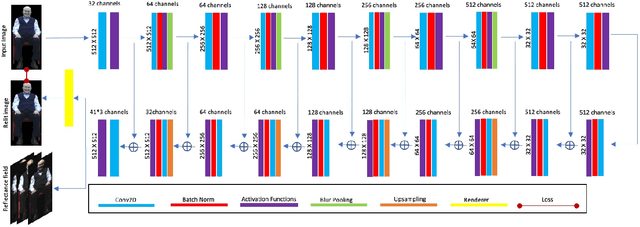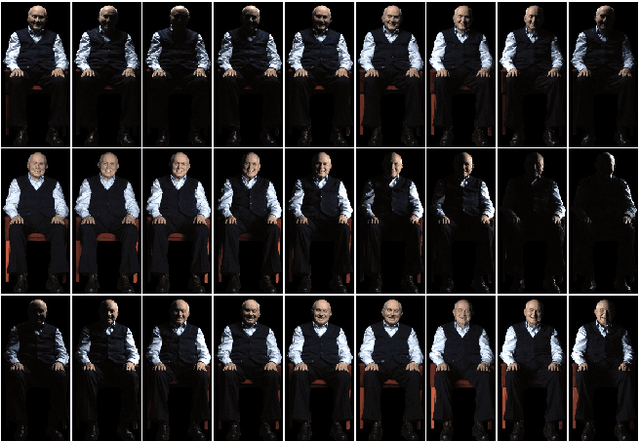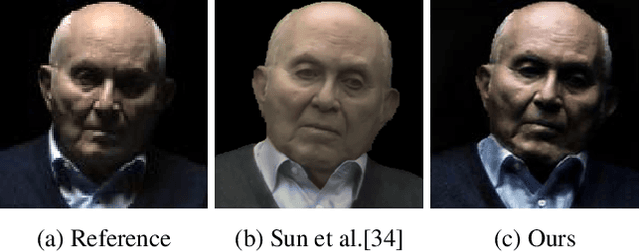Paul Debevec
FlashDepth: Real-time Streaming Video Depth Estimation at 2K Resolution
Apr 09, 2025Abstract:A versatile video depth estimation model should (1) be accurate and consistent across frames, (2) produce high-resolution depth maps, and (3) support real-time streaming. We propose FlashDepth, a method that satisfies all three requirements, performing depth estimation on a 2044x1148 streaming video at 24 FPS. We show that, with careful modifications to pretrained single-image depth models, these capabilities are enabled with relatively little data and training. We evaluate our approach across multiple unseen datasets against state-of-the-art depth models, and find that ours outperforms them in terms of boundary sharpness and speed by a significant margin, while maintaining competitive accuracy. We hope our model will enable various applications that require high-resolution depth, such as video editing, and online decision-making, such as robotics.
Lux Post Facto: Learning Portrait Performance Relighting with Conditional Video Diffusion and a Hybrid Dataset
Mar 18, 2025Abstract:Video portrait relighting remains challenging because the results need to be both photorealistic and temporally stable. This typically requires a strong model design that can capture complex facial reflections as well as intensive training on a high-quality paired video dataset, such as dynamic one-light-at-a-time (OLAT). In this work, we introduce Lux Post Facto, a novel portrait video relighting method that produces both photorealistic and temporally consistent lighting effects. From the model side, we design a new conditional video diffusion model built upon state-of-the-art pre-trained video diffusion model, alongside a new lighting injection mechanism to enable precise control. This way we leverage strong spatial and temporal generative capability to generate plausible solutions to the ill-posed relighting problem. Our technique uses a hybrid dataset consisting of static expression OLAT data and in-the-wild portrait performance videos to jointly learn relighting and temporal modeling. This avoids the need to acquire paired video data in different lighting conditions. Our extensive experiments show that our model produces state-of-the-art results both in terms of photorealism and temporal consistency.
Self-Calibrating Gaussian Splatting for Large Field of View Reconstruction
Feb 13, 2025Abstract:In this paper, we present a self-calibrating framework that jointly optimizes camera parameters, lens distortion and 3D Gaussian representations, enabling accurate and efficient scene reconstruction. In particular, our technique enables high-quality scene reconstruction from Large field-of-view (FOV) imagery taken with wide-angle lenses, allowing the scene to be modeled from a smaller number of images. Our approach introduces a novel method for modeling complex lens distortions using a hybrid network that combines invertible residual networks with explicit grids. This design effectively regularizes the optimization process, achieving greater accuracy than conventional camera models. Additionally, we propose a cubemap-based resampling strategy to support large FOV images without sacrificing resolution or introducing distortion artifacts. Our method is compatible with the fast rasterization of Gaussian Splatting, adaptable to a wide variety of camera lens distortion, and demonstrates state-of-the-art performance on both synthetic and real-world datasets.
Go-with-the-Flow: Motion-Controllable Video Diffusion Models Using Real-Time Warped Noise
Jan 16, 2025



Abstract:Generative modeling aims to transform random noise into structured outputs. In this work, we enhance video diffusion models by allowing motion control via structured latent noise sampling. This is achieved by just a change in data: we pre-process training videos to yield structured noise. Consequently, our method is agnostic to diffusion model design, requiring no changes to model architectures or training pipelines. Specifically, we propose a novel noise warping algorithm, fast enough to run in real time, that replaces random temporal Gaussianity with correlated warped noise derived from optical flow fields, while preserving the spatial Gaussianity. The efficiency of our algorithm enables us to fine-tune modern video diffusion base models using warped noise with minimal overhead, and provide a one-stop solution for a wide range of user-friendly motion control: local object motion control, global camera movement control, and motion transfer. The harmonization between temporal coherence and spatial Gaussianity in our warped noise leads to effective motion control while maintaining per-frame pixel quality. Extensive experiments and user studies demonstrate the advantages of our method, making it a robust and scalable approach for controlling motion in video diffusion models. Video results are available on our webpage: https://vgenai-netflix-eyeline-research.github.io/Go-with-the-Flow. Source code and model checkpoints are available on GitHub: https://github.com/VGenAI-Netflix-Eyeline-Research/Go-with-the-Flow.
Fitting Spherical Gaussians to Dynamic HDRI Sequences
Dec 09, 2024Abstract:We present a technique for fitting high dynamic range illumination (HDRI) sequences using anisotropic spherical Gaussians (ASGs) while preserving temporal consistency in the compressed HDRI maps. Our approach begins with an optimization network that iteratively minimizes a composite loss function, which includes both reconstruction and diffuse losses. This allows us to represent all-frequency signals with a small number of ASGs, optimizing their directions, sharpness, and intensity simultaneously for an individual HDRI. To extend this optimization into the temporal domain, we introduce a temporal consistency loss, ensuring a consistent approximation across the entire HDRI sequence.
DifFRelight: Diffusion-Based Facial Performance Relighting
Oct 10, 2024



Abstract:We present a novel framework for free-viewpoint facial performance relighting using diffusion-based image-to-image translation. Leveraging a subject-specific dataset containing diverse facial expressions captured under various lighting conditions, including flat-lit and one-light-at-a-time (OLAT) scenarios, we train a diffusion model for precise lighting control, enabling high-fidelity relit facial images from flat-lit inputs. Our framework includes spatially-aligned conditioning of flat-lit captures and random noise, along with integrated lighting information for global control, utilizing prior knowledge from the pre-trained Stable Diffusion model. This model is then applied to dynamic facial performances captured in a consistent flat-lit environment and reconstructed for novel-view synthesis using a scalable dynamic 3D Gaussian Splatting method to maintain quality and consistency in the relit results. In addition, we introduce unified lighting control by integrating a novel area lighting representation with directional lighting, allowing for joint adjustments in light size and direction. We also enable high dynamic range imaging (HDRI) composition using multiple directional lights to produce dynamic sequences under complex lighting conditions. Our evaluations demonstrate the models efficiency in achieving precise lighting control and generalizing across various facial expressions while preserving detailed features such as skintexture andhair. The model accurately reproduces complex lighting effects like eye reflections, subsurface scattering, self-shadowing, and translucency, advancing photorealism within our framework.
Jointly Optimizing Color Rendition and In-Camera Backgrounds in an RGB Virtual Production Stage
May 24, 2022



Abstract:While the LED panels used in virtual production systems can display vibrant imagery with a wide color gamut, they produce problematic color shifts when used as lighting due to their peaky spectral output from narrow-band red, green, and blue LEDs. In this work, we present an improved color calibration process for virtual production stages which ameliorates this color rendition problem while also passing through accurate in-camera background colors. We do this by optimizing linear color correction transformations for 1) the LED panel pixels visible in the field of view of the camera, 2) the pixels outside the field of view of the camera illuminating the subjects, and, as a post-process, 3) the pixel values recorded by the camera. The result is that footage shot in an RGB LED panel virtual production stage can exhibit more accurate skin tones and costume colors while still reproducing the desired colors of the in-camera background.
NeRFactor: Neural Factorization of Shape and Reflectance Under an Unknown Illumination
Jun 03, 2021



Abstract:We address the problem of recovering the shape and spatially-varying reflectance of an object from posed multi-view images of the object illuminated by one unknown lighting condition. This enables the rendering of novel views of the object under arbitrary environment lighting and editing of the object's material properties. The key to our approach, which we call Neural Radiance Factorization (NeRFactor), is to distill the volumetric geometry of a Neural Radiance Field (NeRF) [Mildenhall et al. 2020] representation of the object into a surface representation and then jointly refine the geometry while solving for the spatially-varying reflectance and the environment lighting. Specifically, NeRFactor recovers 3D neural fields of surface normals, light visibility, albedo, and Bidirectional Reflectance Distribution Functions (BRDFs) without any supervision, using only a re-rendering loss, simple smoothness priors, and a data-driven BRDF prior learned from real-world BRDF measurements. By explicitly modeling light visibility, NeRFactor is able to separate shadows from albedo and synthesize realistic soft or hard shadows under arbitrary lighting conditions. NeRFactor is able to recover convincing 3D models for free-viewpoint relighting in this challenging and underconstrained capture setup for both synthetic and real scenes. Qualitative and quantitative experiments show that NeRFactor outperforms classic and deep learning-based state of the art across various tasks. Our code and data are available at people.csail.mit.edu/xiuming/projects/nerfactor/.
A New Dimension in Testimony: Relighting Video with Reflectance Field Exemplars
Apr 06, 2021



Abstract:We present a learning-based method for estimating 4D reflectance field of a person given video footage illuminated under a flat-lit environment of the same subject. For training data, we use one light at a time to illuminate the subject and capture the reflectance field data in a variety of poses and viewpoints. We estimate the lighting environment of the input video footage and use the subject's reflectance field to create synthetic images of the subject illuminated by the input lighting environment. We then train a deep convolutional neural network to regress the reflectance field from the synthetic images. We also use a differentiable renderer to provide feedback for the network by matching the relit images with the input video frames. This semi-supervised training scheme allows the neural network to handle unseen poses in the dataset as well as compensate for the lighting estimation error. We evaluate our method on the video footage of the real Holocaust survivors and show that our method outperforms the state-of-the-art methods in both realism and speed.
Baking Neural Radiance Fields for Real-Time View Synthesis
Mar 26, 2021



Abstract:Neural volumetric representations such as Neural Radiance Fields (NeRF) have emerged as a compelling technique for learning to represent 3D scenes from images with the goal of rendering photorealistic images of the scene from unobserved viewpoints. However, NeRF's computational requirements are prohibitive for real-time applications: rendering views from a trained NeRF requires querying a multilayer perceptron (MLP) hundreds of times per ray. We present a method to train a NeRF, then precompute and store (i.e. "bake") it as a novel representation called a Sparse Neural Radiance Grid (SNeRG) that enables real-time rendering on commodity hardware. To achieve this, we introduce 1) a reformulation of NeRF's architecture, and 2) a sparse voxel grid representation with learned feature vectors. The resulting scene representation retains NeRF's ability to render fine geometric details and view-dependent appearance, is compact (averaging less than 90 MB per scene), and can be rendered in real-time (higher than 30 frames per second on a laptop GPU). Actual screen captures are shown in our video.
 Add to Chrome
Add to Chrome Add to Firefox
Add to Firefox Add to Edge
Add to Edge